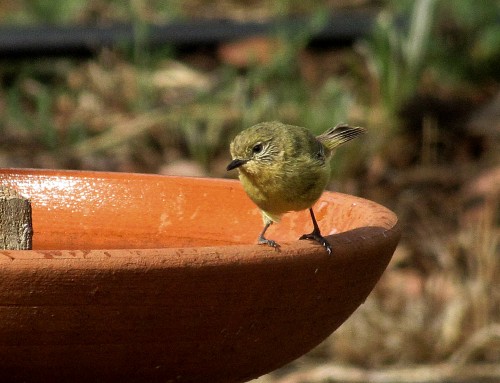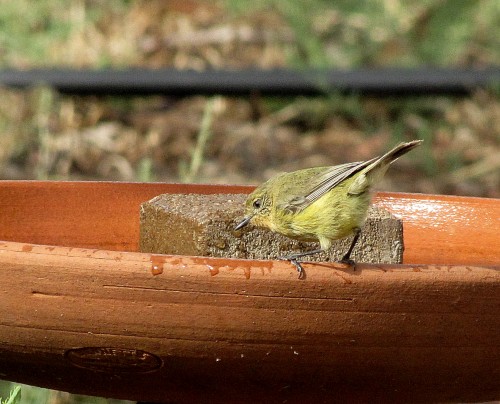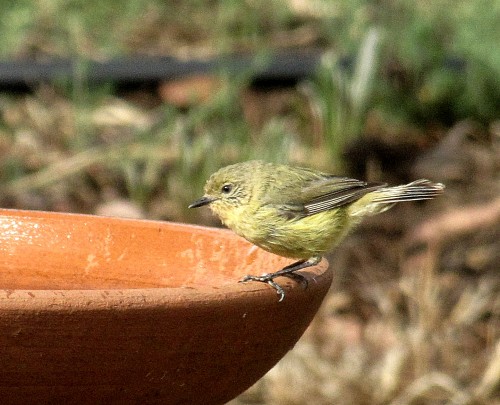Yellow Thornbills at our bird bath
The most common thornbill species in our garden is the Yellow-rumped Thornbill. This is a resident breeding species and we see small flocks of up to 20 almost every day. If we searched our whole property we would probably see them every day.
Less common is the Yellow Thornbill shown in today’s photos. This species, also known as the Little Thornbill, is a regular visitor. On a recent hot day a small flock came hesitatingly to our bird bath. Some of the larger birds such as the honeyeaters can be quite bossy and this makes this tiny visitor nervous and flighty, so I was pleased to get a series of close up photos.
As an added bonus, I managed to catch one of them landing but still in flight – check out the last photo below.
Little Thornbills take a bath
We have many different birds resident or visiting in our garden and adjacent mallee scrub. We have quite a few thornbills, species which are always a challenge to identify. Many of them are little brown birds which move quickly and are hard to hold in focus for long with binoculars. Most are even harder to focus on with a camera.
I have over the years managed reasonable photos of the common Yellow-rumped Thornbill. I have fewer good photos of the occasional visiting Chestnut-rumped Thornbills. And until earlier this week I had no photos of the elusive Little Thornbill which is also called the Yellow Thornbill. This species is commonly heard and seen in our garden and nearby, but never have I managed to capture one with my camera.
Earlier this week a loose flock of about 6 of this lovely species came to one of our bird baths. they flitted in and out of the water, zipping to branches high above to preen before diving down to the water ago. I had to be very patient with my camera, making sure it was focussed on the edge of the bird bath in anticipation before snapping them. I was pleased to manage three reasonable shots.
Further reading:
Birds in the heat
We are only half way through summer here in South Australia and already we’ve had some very hot days and several heatwaves. (In this part of the world a heatwave is considered to be five or more consecutive days of 35C (95F). ) During this last week we had several days where the maximum hovered around the 42 -45C mark (45C = 113F).
During our hot days, and especially during a heat wave, our native birds suffer terribly. Many beat a path frequently to the various bird baths we have in our garden. On a few occasions some of them have gathered near the windows where the cool air from our evaporative air conditioning leaves the house.
A few days ago I saw a different technique for keeping cool. The wind was blowing a gale from the north and the temperature reached 45.2C. A flock of 17 Yellow-rumped Thornbills, two Brown-headed Honeyeaters and a Willie Wagtail gathered on the leeward side of the house in the shade. It seemed to do the trick on a very nasty day.
Active Yellow-rumped Thornbills
One of the common resident bird species in our garden and on our five acre block is the Yellow-rumped Thornbill. Every day we see flocks of 8-10 foraging on the ground in most parts of our property. I love seeing them hopping around or flying low across the garden, their bright yellow tails brilliant in the sunshine. They are regular visitors to the bird baths too during the warmer months of the year.
At present they are extremely active. The warmer spring weather is with us and so they are probably nesting somewhere too. It’s just that I haven’t yet found their nest.
Related articles:
An air conditioned Thornbill
We are in the midst of a heatwave this week. On Monday it reached 40C (104F), yesterday 45C (113F) and it looks like another 40+ day today.
Our poor garden birds – along with birds everywhere, suffer greatly during such extreme temperatures. I try to keep the supply of water in the bird baths up during these times, something they much appreciate if the constant stream of birds is anything to go by.
During the worst of the heat yesterday I was working in my office. I was being kept cool by the gentle flow of cool air from our evaporative air conditioner. This type of cooler needs an open window to create a flow of cool air into a room. The window alongside of me was ajar a few centimetres.
I was suddenly aware of a Yellow-rumped Thornbill cooling itself in the flow of air escaping from my office. He twittered in appreciation for about five minutes, wings held out to catch the refreshing air, before flying off to catch afternoon tea.
It was a lovely interruption to my afternoon of writing.
Related articles:










